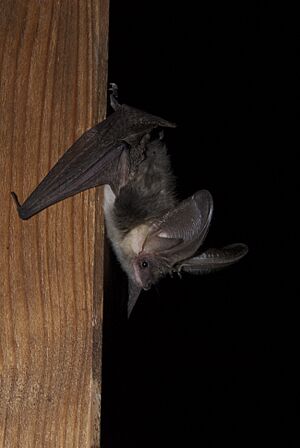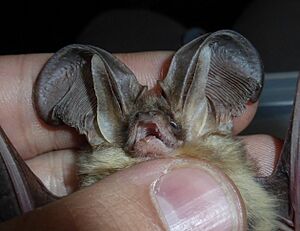Alpine long-eared bat facts for kids
Quick facts for kids Alpine long-eared bat |
|
|---|---|
 |
|
| Conservation status | |
| Scientific classification | |
| Synonyms | |
|
The Alpine long-eared bat or mountain long-eared bat (Plecotus macrobullaris) is a type of long-eared bat. It was first found and described in Switzerland and Austria in 1965. People thought it was a mix between the brown long-eared bat and the grey long-eared bat. Later, in 2002, it was described again from France and Austria. Even though its name suggests it lives only in the Alps, this bat is also found in places like Croatia and Bosnia and Herzegovina. You can tell it apart from other European long-eared bats, like the brown long-eared bat, because its belly is white.
Contents
How This Bat Got Its Name
In 1965, a scientist named A. Kuzjakin first described this bat. He thought it was a new kind of brown long-eared bat, so he called it Plecotus auritus macrobullaris.
Later, in 2002, two other groups of scientists also described this bat. Andreas Kiefer and Michael Veith called it Plecotus alpinus. Around the same time, Friederike Spitzenberger and her team called it Plecotus microdontus.
Scientists then used DNA tests to figure out if these were all the same bat. They found out that P. alpinus and P. microdontus were actually the same as the bat Kuzjakin described in 1965. Because Kuzjakin's name was the oldest, it became the official name. The bat was then recognized as its own species, Plecotus macrobullaris.
The name "macrobullaris" comes from old Greek and Latin words. "Makrós" means "long" and "bulla" means "knob-shaped." This might refer to a part of the bat's ear bone.
Where Alpine Long-Eared Bats Live
The Alpine long-eared bat lives in many mountainous areas. You can find it in Andorra, France, and Spain in the Pyrenees mountains. In the Alps, it lives from France all the way to Slovenia. It also lives in the Dinaric Alps and across the Balkans to Greece.
These bats are also found on islands like Crete and Corsica. In Asia, they live in Anatolia (part of Turkey) and through the Caucasus region, reaching as far south as Iran and Syria. They usually prefer steep mountains, living as high as 2,800 meters (about 9,200 feet). However, sometimes they can be found at sea level.
Scientists have found that there are two main groups of these bats. These groups separated over a million years ago. They are called:
- P. m. macrobullaris: These bats live east of the Alps.
- P. m. alpinus: These bats live in the Alps and Pyrenees.
What They Look Like
The Alpine long-eared bat is a medium-sized bat. Its forearm is about 4 centimeters (1.6 inches) long. It weighs between 6 and 10 grams (about 0.2 to 0.35 ounces).
Its fur is pale grey over most of its body. The fur on its belly is almost white. Its face is dark brown. As its name suggests, it has long ears. A pink, triangle-shaped pad sticks down from its chin. Male and female bats look the same in size and color.
How They Live and Behave
Alpine long-eared bats mainly eat moths. They catch these moths in open areas like grasslands and alpine meadows.
They use echolocation to find their food. This means they make very quiet sounds that bounce off objects. These sounds help them "see" their surroundings and find insects in the dark. Their calls are very faint and sweep down from 46 to 23 kHz. Each call lasts up to 7 milliseconds.
These bats can be flexible about where they sleep, which are called roosts. In the Pyrenees, they often roost in natural rock cracks. But in the Alps, they seem to prefer sleeping in the attics of human homes. Sometimes, they share their roosts with other types of bats, but this is not common.
Male bats often change their roosting spots almost every day. Female bats, however, tend to stay in the same place for longer periods. They gather together in groups called brooding colonies, which can have 5 to 25 bats.



